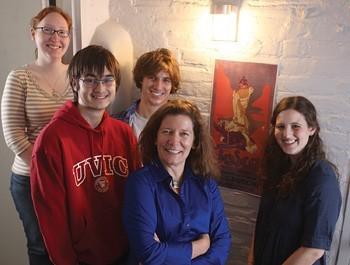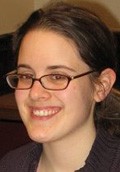
Assistant Professor of History Kelly Maynard (center) with students (clockwise from lower left) Paul Dampier ’12, Kim Knudsen ’10, Erik Jarvis ’12, and Briel Waxman ’12. Knudsen authored the review titled “Italian Opera Insults Catholics.” Photographer: Jim Heemstra
Each student in the course Tyrants and Tunesmiths: Music and the State in Modern Europe wrote a review based upon the experience of the performance, but adopting the perspective of a particular cultural or political figure from the original premiere in 1900 in Rome.
According to Assistant Professor of History Kelly Maynard, the exercise provides a good way for students to apply the historical training they have been receiving in this unique course to their evening at the opera.
Two students share their reviews:
Kim Knudsen ’10 — Role: Offended Catholic

Kim Knudsen ’10 wrote this review of Tosca from the point of view of an offended Catholic.
Italian Opera Insults Catholics
by Kim Knudsen
The weather in Rome is quite miserable this time of year, but the activities of the Holy Year have done much to keep my mind off the cold and the rain. After being thoroughly exhilarated by my religious activities, I decided to enjoy some of the sites of Rome and was fortunate enough to be able to see the new opera by Puccini called Tosca. Although my recounting of these events may sound positive, Rome is the location of many small anticlerical factions, which although annoying to those traveling for the Holy Year, did very little to bother us. The one place I was not expecting to see these hostilities was at the Teatro Costanzi, where Tosca premiered. Although I was delighted in being able to participate in the events of the Holy Year, my voyage was troubled by the anarchists who caused strife around the city as well as the events of Tosca, which darkened my mood.
The city itself was crowded and so was the opera theatre. The streets were overrun with individuals unable to find a hotel room who had to resort to living outside. Luckily, I was able to find a hotel due to my early arrival in Rome. The Teatro Costanzi was also filled to capacity with Italian dignitaries and I heard that Queen Margherita also attended, but I was not fortunate enough to see her with my own eyes. Being quite excited when the opera was scheduled to begin, I was concerned when it was brought to a halt and there were rumors of a bomb threat being murmured around me in several different languages. Besides their nervous mumblings, the audience was altogether polite, even though there were attendees that held very negative views of Puccini, including several of his critics. The building itself was rather luxurious, and although it was able to hold a large number of people, was very crowded, and the seat that I occupied was quite far away from the stage, so distant in fact, that I wished that I had brought some opera glasses. The sound carried well, even to my far away seat, even though I was unimpressed by what I was hearing as a whole, but if a more favorable opera was performed there, I can imagine my opinion to be far more positive than it is.
Tosca is done in by its very poor taste, as it is very violent and the characters seem to be lacking in any unique characteristics, but aspects of the opera besides the plot were performed beautifully. The technical characteristics of the opera were well done, including the lighting as well as the costumes, especially Tosca’s when she was in a crimson gown. The color was rather stunning and reflected the violence that would occur later in the opera, a foreshadowing, if you will, through her garment. The lighting was beautiful, as well as the props, which added to the setting. The major problems I had occurred in the second act of the opera. The setting was very minimal compared to the rest of the opera and although the lighting was stunning and added a frightening element of the shadows of Tosca and Scarpia climbing up the wall, much of the effect was lost due to my seat. I was unable to see whether Scarpia remained on stage though Tosca’s aria and this desire to know lost some of the suspenseful effects that were occurring in other parts of the opera.
This opera was rather disturbing due to its portrayal of the Catholic Church. The opera contains two murders, a suicide, a torture scene, and an attempted rape; all of these elements disturbed me greatly. Yet, the portrayal of Scarpia, a police commander who seems devout but is willing to mislead characters and use his power to influence others’ actions, is probably the most disturbing character to me. The man is a representation of the Catholic Church and to have him be so deplorable in nature astounds me, and to add insult to injury, the fact that this premiered during the Holy Year is very offensive. Aside from the plot, the singers performed exquisitely and their acting helped to add some life to the characters that were not very developed. The music was also rather disappointing, as some of the music does not relate to the stage action at all. For instance at the beginning of the third act, a beautiful sweet song begins with a lovely flute and French horn melody, but the scene opens on Cavaradossi who believes he is going to be executed. The scene, I thought, should have darker music to go with the mood. The lead soprano was excellent in supplying the necessary emotions with her voice, and her arias gave me chills several times during the performance. Both the singers and the performers did the best they could to add the necessary sensations into the pieces they were performing, because the libretto was short, blunt, and right to the point of action and had little room for the feelings of the audience to come to fruition, instead going from major event to major event without a period of calm.
Overall, I have mixed feelings about my trip to Rome. Although I immensely enjoyed the events of the Holy Year, seeing the opera Tosca has upset me and made my experience in Rome one that I would not care to repeat. Although the technical aspects of the opera were rather enjoyable, the plot and the characteristics of Scarpia have left a sour impression in my mind of how the Catholic Church is portrayed in its home country. If the opera had been different, I would have enjoyed my experience in Rome a lot more. In fact, I could not understand why the performers received several curtain calls, perhaps only for their skill and not Puccini’s; regardless, I clapped along in order to be polite, but as a whole I was not impressed by this opera. If I were to do this again, I believe that I would enjoy the events of the Holy Year very much and hope that the city itself is in less discord, but I would not attend an opera for it might give me a false impression of how the church is operating in Italy. Until then, I am very content to be back in my Spanish homeland and will continue to celebrate the Holy Year in a safer, more enjoyable place.
Anne Weeks ’10 — Role: Eager-to-Please Reviewer
 Anne Weeks ’10 wrote this review of Tosca from the point of view of an eager-to-please reviewer.
Anne Weeks ’10 wrote this review of Tosca from the point of view of an eager-to-please reviewer.
October 3
Giulio Ricordi
Casa Ricordi
2 Via Berchet
20121 Milano
Signor Ricordi,
Please find enclosed a copy of my review of the October 3 premiere of Giacomo Puccini’s Tosca at the Chicago Lyric Opera, to be published in tomorrow’s paper. I hope that you will find it sufficiently complimentary for the promotion of Puccini’s work, and that I have preemptively addressed some of the points likely to be criticized by Signor Torrefranca.
The opera was a pleasure to watch, and I sincerely hope it does not suffer the box office disaster you anticipated.
Yours,
Anne Weeks, freelance music critic
Enc.
October 4
Tosca: Puccini’s Latest Triumph
by Anne Weeks
Years of waiting have finally been rewarded! Last night’s premiere of Giacomo Puccini’s Tosca at the Chicago Lyric Opera was an event worthy of the international reputation of Verdi’s heir. After such a performance, it may now be said that even on a crisp, overcast Chicago night, a ray of Tuscan sun may shine.
Although far from the composer’s home, the Chicago Lyric Opera has proven itself a worthy vessel for Puccini’s masterpiece. The elegant décor of the opera house, reminiscent of its prestigious European counterparts complete with golden flower motifs and richly colored wall panels, befits the début of such a highly anticipated work. Modern advances, however, also have their place: the orchestra is hidden in a pit below the stage, after the German fashion, and there is not a single obstructed view in the house. This last improvement was, to be sure, much appreciated by the multitudes of spectators who filled the theatre, anxious to be among the first to witness the newest Italian triumph. Come from far and wide, these people filled the theatre with countless languages, no doubt expressing their great anticipation, as we awaited the beginning of the piece, but all was silent as the curtain rose and the music began.
From the first, the remarkable acoustics of the venue, seemingly tailored to the needs of Puccini’s music, were noticed. Not a note of the beautifully exposed woodwind passages, nor a word sung onstage, was lost to the eager ear of the spectator, even in the highest tier of seats where perched your humble correspondent, and the powerful harmonic passages, incorporating the entire orchestra, filled the hall. This extraordinary dynamic range, and the variation in orchestration which so expertly sets the tone, showcase the composer’s individuality: refusing to be bound by Wagnerian ideas of organicism, he rises above any such equation to create a music that is truly Italian.
The production of the opera was also fantastic. The lavish costumes were realistic, tailored to the role of each character so that the visual aspect alone could be used to supply each figure’s pedigree. My readers in Italy will appreciate my noting that the representation of a cathedral was very well done, even in America, showing a great attention to detail. Scarpia’s bureau and the castle were also well represented, with the former set in an Italian color scheme dominated by red and gold and the latter an accurate likeness of a typical Italian fortress. However, it was not the sets themselves that were most impressive, but the lighting. In the second act, especially, the use of shadow to suggest actions taking place just off stage was a brilliant innovation. Nonetheless, even this carefully crafted space would not do justice to the opera, were it not populated by singers worthy of Tosca’s premiere.
Performers can make or break an opera, no matter how brilliant the composer, and, with so much of the opera devoted to scenes with only one or two characters, Tosca is especially dependent on the quality of the singers. The Chicago Lyric Opera is, therefore, fortunate to have such talents as Deborah Voigt, in the title role; Vladmir Galouzine, as Tosca’s lover Cavaradossi; and James Morris, as the devious Baron Scarpia. The chemistry between Voigt and Galouzine is especially remarkable in the first act, with their spectacular performance of the repartee between Tosca and her lover, and, of course, during the moving duet in the last act as Cavaradossi awaits execution.
All of the performers not only sang magnificently, but also truly embodied their character, perfectly conveying the host of complex passions found in this opera. Puccini’s skillful portrayal of emotions reinforces the Italian nature of his art: here there are no Germanic formulas, but only spontaneous feeling that warms the work from within like the Italian sun. In this way, Tosca is an improvement, even over its predecessor, La Bohème, in that the new work represents man’s strongest passions, and not merely an ambiance, as certain critics had claimed of Puccini’s earlier work.
The quality of the performance was not lost upon the audience, which was almost completely silent during each act and seemed quite fascinated by the action on stage. Each intermission, however, saw the halls outside the theatre filled with people of all ages, from young children to those of an advanced age. It was heartwarming to see the crowds that had gathered, many in elegant attire, to view the latest work of Italy’s most talented and beloved composer. The singers were called out for numerous curtain calls, facing thunderous applause from the delighted American audience. Yet again, Giacomo Puccini has proven himself the successor to the internationally renowned Verdi, a composer whose works will continue to remind the world that Italy is now, and always shall be, the home of great opera. I congratulate Signor Puccini on his latest triumph and speak for many, I am sure, when I express my impatience for his next success.
For those who wish to view the latest Italian masterpiece for themselves, a production of Tosca is planned in Rome, where tickets will soon be available. For more information write to Ricordi Publishing House at:
Casa Ricordi
Via Berchet 2
20121 Milano
Originally published as an online web extra for The Grinnell Magazine, Winter 2009